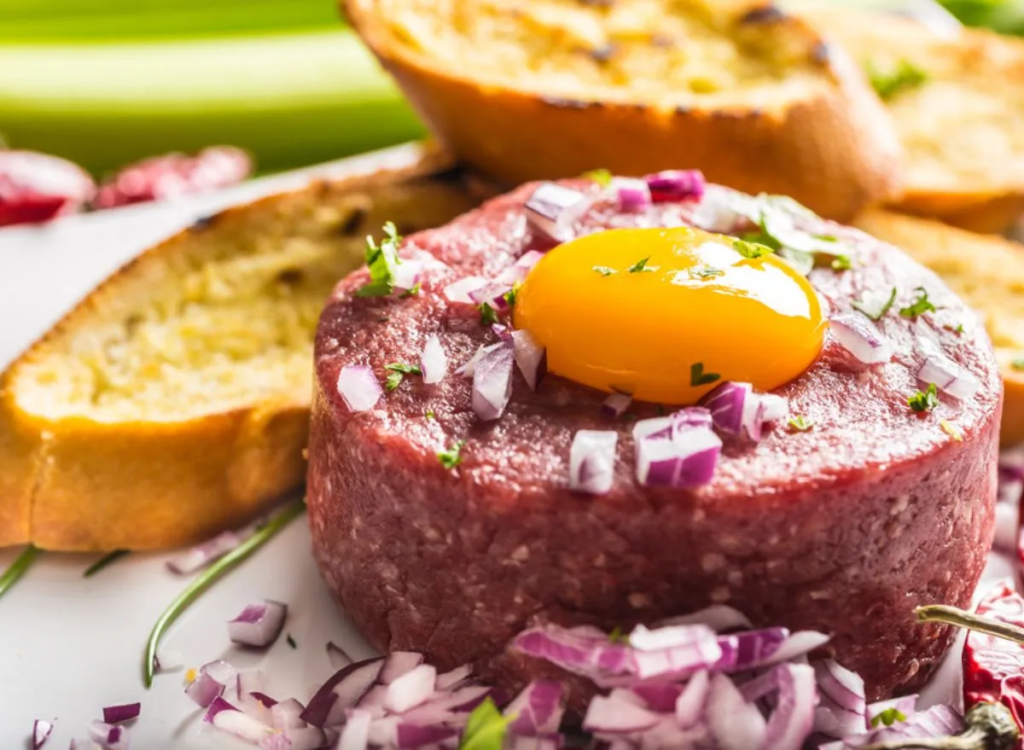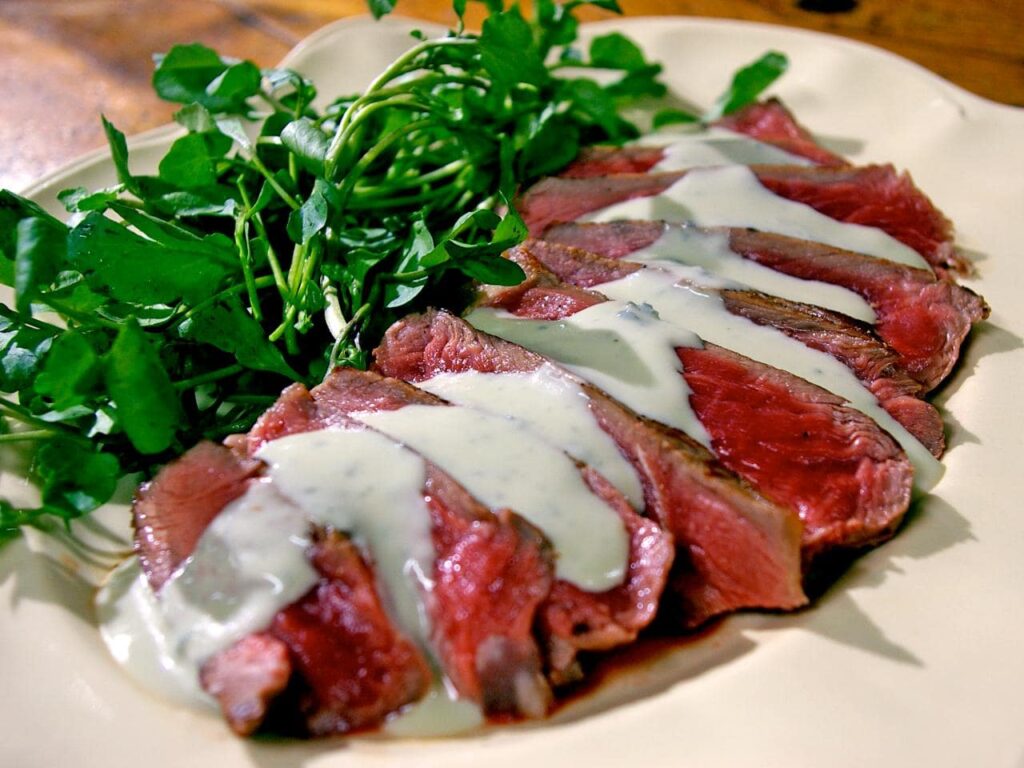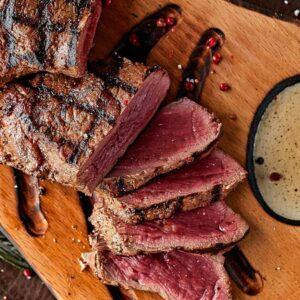Welcome to the world of Blue Beef Steak, where culinary boundaries are pushed and flavor reigns supreme! Blue Steak, the rarest and most adventurous level of doneness for beef, beckons those with a passion for bold flavors and tender textures. In this guide, we’ll embark on a journey to uncover the secrets of Blue Beef Steak, from its origins to mastering the art of cooking it at home.
You’ll learn about the distinct characteristics of Blue Steak, the importance of selecting high-quality beef, and the essential steps for achieving perfection on your plate. Whether you’re a seasoned chef or a curious home cook, prepare to elevate your steak game to new heights as we delve into the world of Blue Beef Steak. Get ready to tantalize your taste buds and impress your guests with this culinary masterpiece!
Understanding Blue Beef Steak:
What is Blue Beef Steak?
Blue Steak is a unique level of doneness for beef that sits at the rarest end of the spectrum. Essentially, it’s a steak that’s been swiftly seared on the outside while the interior remains predominantly raw. This means the steak retains a cool temperature at its core, offering a texture and flavor profile that’s distinct from more traditional cooking methods.
Characteristics of a Blue Steak:
A Blue Beef Steak is easily distinguishable by its appearance and texture. On the outside, it boasts a charred crust resulting from the quick sear, which provides a delightful contrast to the vibrant red hue of the raw interior. The texture of a Blue Steak is incredibly tender and juicy, with a slight resistance when bitten into. This combination of textures and flavors creates a culinary experience that’s both luxurious and adventurous.
Difference between Blue Steak and other degrees of doneness (Rare, Medium Rare, etc.):

The primary difference between Blue Steak and other degrees of doneness, such as Rare, Medium Rare, and beyond, lies in the level of cooking and the internal temperature reached.
- Rare: A Rare steak is cooked to an internal temperature of around 125°F (52°C) and has a warm, red center.
- Medium Rare: This level of doneness sees the steak cooked to an internal temperature of about 135°F (57°C), resulting in a pink center with some warmth.
- Medium: At around 145°F (63°C), a Medium steak has a pink center with more pronounced warmth.
- Medium Well: A Medium Well steak is cooked to about 150°F (66°C) and has a slightly pink center with minimal juiciness.
- Well Done: This is the most well-cooked option, with an internal temperature of 160°F (71°C) or higher, resulting in a fully browned and often drier texture.
In contrast, Blue Beef Steak is cooked so briefly that the internal temperature remains significantly lower, typically around 115°F (46°C). As a result, the steak retains its raw characteristics, offering a cooler temperature and a texture that’s more akin to sushi than traditional steak.
Choosing the Right Cut of Beef:
Importance of Selecting High-Quality Beef for Blue Steak:
Choosing high-quality beef is essential for achieving the best results when cooking Blue Steak. High-quality beef typically comes from well-raised animals, which have been fed a nutritious diet and given proper care throughout their lives.
When it comes to Blue Steak, the quality of the beef directly impacts both the flavor and texture of the final dish. High-quality beef tends to be more tender, flavorful, and well-marbled, resulting in a more enjoyable eating experience. Additionally, high-quality beef is often free from additives and hormones, ensuring a more natural and wholesome meal.
Recommended Cuts for Blue Steak:
While virtually any cut of beef can be cooked to a Blue Steak level of doneness, certain cuts are particularly well-suited to this cooking method. These cuts typically have a combination of tenderness and flavor that shines when cooked quickly over high heat. Some recommended cuts for Blue Beef Steak include:
- Filet Mignon: Known for its exceptional tenderness, Filet Mignon is a popular choice for Blue Steak. Its lean profile and buttery texture make it ideal for cooking quickly to preserve its natural flavors.
- Ribeye: With its generous marbling and rich flavor, Ribeye is another excellent choice for Blue Steak. The marbling melts during cooking, adding moisture and depth of flavor to the steak.
Tips for Selecting the Right Thickness of Steak:
The thickness of the steak plays a crucial role in achieving the perfect Blue Steak. Here are some tips for selecting the right thickness:
- Consider Cooking Time: Thicker steaks require more time to cook through the center while still achieving the desired sear on the outside. Thinner steaks cook more quickly but can be challenging to sear without overcooking.
- Balance Texture and Cooking Time: Aim for a steak that’s thick enough to retain its juiciness and tenderness while still allowing for a quick sear. Typically, steaks around 1 to 1.5 inches thick are ideal for Blue Steak.
- Uniformity: Choose steaks that are evenly cut to ensure consistent cooking. Variations in thickness can result in uneven cooking, with some parts of the steak being more done than others.
By selecting high-quality beef and the right cut and thickness of the steak, you set the stage for a delicious Blue Beef Steak experience. These choices not only enhance the flavor and texture of the final dish but also contribute to a more enjoyable culinary adventure.
Preparing Your Blue Beef Steak:
Properly Thawing the Steak if Frozen:
Thawing frozen steak properly is crucial to ensure even cooking and food safety. Here’s how to do it:

- Refrigerator Method: Place the frozen steak on a plate or tray and transfer it to the refrigerator. Allow it to thaw slowly overnight or for several hours until completely thawed. This gradual thawing method helps maintain the quality and texture of the meat.
- Cold Water Method: If you need to thaw the steak more quickly, you can use the cold water method. Place the frozen steak in a sealed plastic bag and submerge it in a bowl of cold water. Change the water every 30 minutes to ensure it remains cold. Thawing this way typically takes 1-2 hours, depending on the thickness of the steak.
- Microwave Method (Not Recommended): While it’s possible to thaw steak in the microwave, it’s not the preferred method as it can result in uneven thawing and may partially cook the steak, compromising its texture.
Regardless of the method you choose, never thaw steak at room temperature, as it can promote bacterial growth and foodborne illness.
Seasoning Options for Blue Steak:
When it comes to seasoning Blue Beef Steak, simplicity is key to allowing the natural flavors of the beef to shine. Here are some seasoning options to consider:
- Salt and Pepper: A classic combination of salt and freshly ground black pepper is all you need to enhance the flavor of Blue Steak. Season the steak generously on both sides just before cooking.
- Steak Rubs: If you prefer a bit more flavor, you can use a steak rub or seasoning blend. Look for blends that contain ingredients like garlic, onion, herbs, and spices. Apply the rub evenly to the steak before cooking.
- Marinades (Optional): While marinating Blue Steak isn’t traditional, you can experiment with simple marinades if you prefer. Opt for marinades that are acidic and contain minimal sugar to prevent the steak from cooking too much during marinating. Keep the marinating time short, around 30 minutes to 1 hour, to avoid compromising the steak’s texture.
Preparing Any Accompanying Sides or Sauces:
While Blue Steak is delicious on its own, you can elevate the meal by pairing it with complementary sides and sauces. Here are some ideas:
- Side Dishes: Choose sides that balance the richness of the steak. Roasted vegetables, such as asparagus or Brussels sprouts, are a popular choice. You can also serve a crisp salad with a tangy vinaigrette or creamy mashed potatoes.
- Sauces: Blue Steak pairs well with simple sauces that enhance its flavor without overpowering it. Classic steak sauces like chimichurri, peppercorn sauce, or a red wine reduction are excellent options. Alternatively, a dollop of compound butter infused with herbs or garlic adds richness and depth to the steak.
Prepare any accompanying sides or sauces while the steak is cooking to ensure everything is ready to serve together. This ensures a well-rounded and satisfying dining experience that highlights the star of the show: the Blue Steak.
Cooking a Steak Blue:
Essential Equipment Needed for Cooking a Steak Blue:
- Grill or Skillet: You’ll need a grill or a heavy-bottomed skillet, such as a cast-iron skillet, to achieve the high heat required for searing the steak.
- Tongs: Tongs are essential for flipping the steak and handling it safely during the cooking process.
- Meat Thermometer: While not strictly necessary, a meat thermometer ensures accuracy when monitoring the internal temperature of the steak to achieve the desired level of doneness.
Step-by-Step Guide to Cooking a Steak Blue:
- Preparing the Grill or Skillet:
- Preheat your grill or skillet over high heat. You want it to be smoking hot to achieve a good sear.
- If using a grill, make sure the grates are clean and well-oiled to prevent sticking.
- Searing the Steak on High Heat:
- Place the seasoned steak on the hot grill or skillet. It should sizzle immediately upon contact.
- Cook the steak for about 1-2 minutes on each side, depending on the thickness of the steak. You’re aiming for a deeply caramelized crust on the outside while keeping the interior cool and raw.
- Monitoring the Internal Temperature:
- Use a meat thermometer to check the internal temperature of the steak. For Blue Steak, the internal temperature should be around 115°F (46°C).
- Insert the thermometer into the thickest part of the steak, avoiding contact with any bones or the cooking surface.

- Resting the Steak Before Serving:
- Once cooked to the desired level of doneness, remove the steak from the heat and transfer it to a cutting board.
- Allow the steak to rest for a few minutes before slicing. This resting period allows the juices to redistribute throughout the steak, resulting in a juicier final product.
Tips for Perfect Blue Steaks:
Ensuring Proper Food Safety Practices:
- Always practice good food safety habits when handling raw meat, including washing your hands and utensils thoroughly after contact.
- Cook the steak to the recommended internal temperature to ensure any harmful bacteria are killed off.
Adjusting Cooking Times Based on Steak Thickness:
- Thicker steaks will require longer cooking times to achieve the desired sear while keeping the interior cool. Adjust your cooking times accordingly based on the thickness of the steak.
Checking for Doneness Using Touch or a Meat Thermometer:
- While a meat thermometer is the most accurate way to check for doneness, you can also use the touch test. A Blue Steak will feel very soft to the touch and offer little resistance when pressed with your finger.
Common Mistakes to Avoid:
Overcooking a Steak Blue: Overcooking a Steak Blue will result in a loss of its unique texture and flavor. Keep a close eye on the cooking time to ensure you achieve the desired level of doneness.
Using Low-Quality or Improperly Aged Beef: The quality of the beef directly impacts the outcome of your Blue Steak. Choose high-quality, well-marbled cuts for the best results.
Skipping the Resting Period Before Serving: Skipping the resting period can result in a loss of juices and a less tender steak. Be patient and allow the steak to rest for a few minutes before slicing and serving.
Conclusion
Congratulations, you’re now a Blue Beef Steak aficionado! By following the tips and techniques outlined in this guide, you’ll be able to cook up perfectly seared Blue Steaks right in your kitchen. Whether you’re hosting a dinner party or treating yourself to a special meal, Blue Steak is sure to impress. So fire up the grill or heat the skillet and get ready to experience the ultimate in steak perfection. Happy cooking!
READ MORE: Unveiling the Secrets: The Incredible Impact of Fruit Gushers Ingredients

